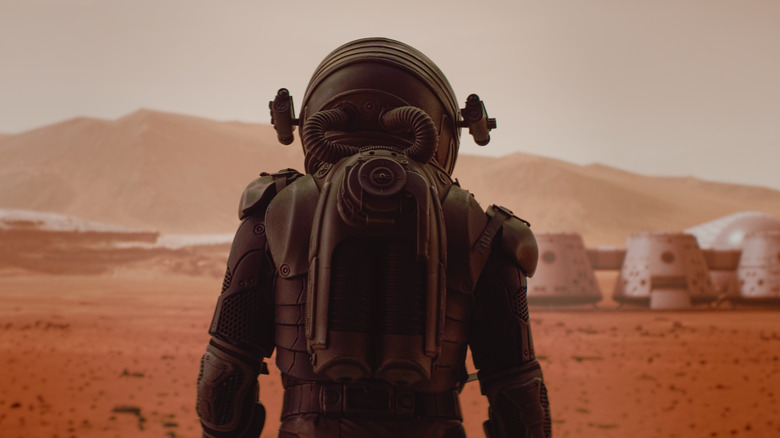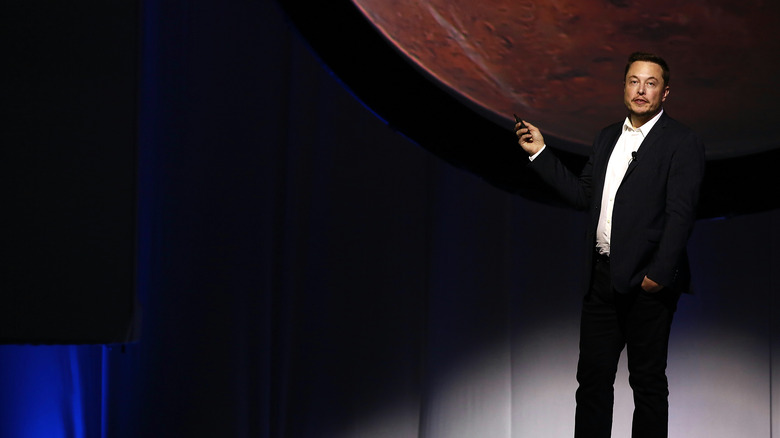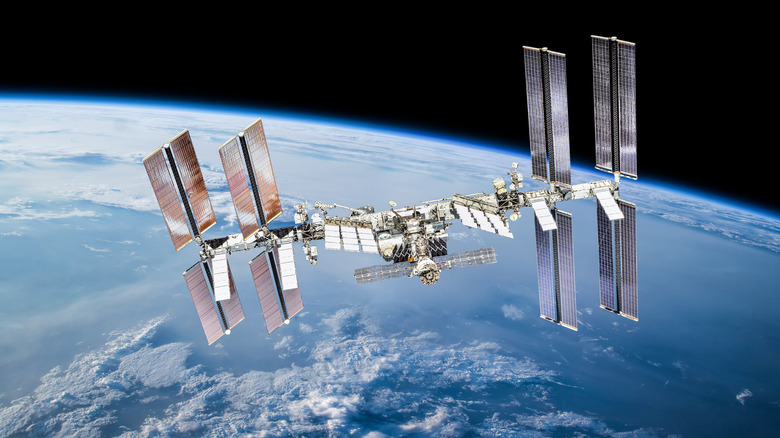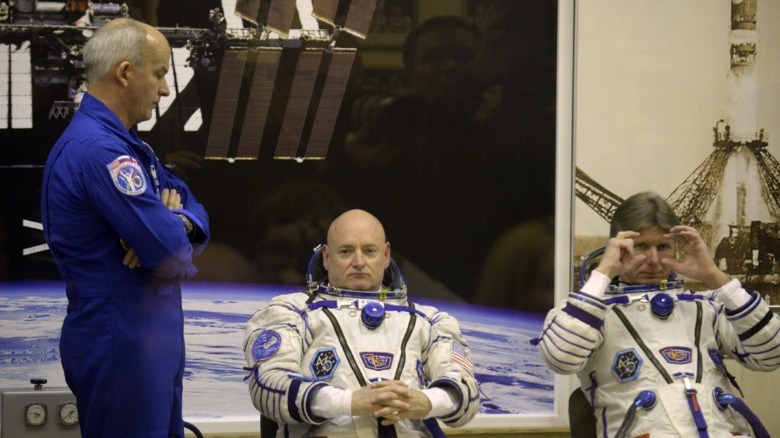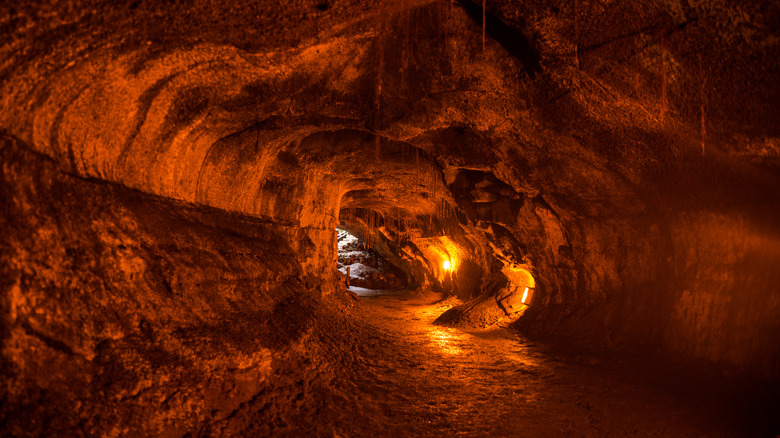Why Neil deGrasse Tyson Is Skeptical About Mars Colonization
Humanity has been dreaming about living on Mars for hundreds of years. In the late 1880s, the red planet inspired science fiction writers. Novels like "Aleriel, or A Voyage to Other Worlds" by W. S. Lach-Szyrma were filled with pages where imagination ran wild. Very little was scientifically known about Mars and many things seemed possible at the time, including humanoid creatures called "Martians," oceans, and a distant future where humans lived in cities on the planet.
As science matured and our understanding of Mars increased, humanity soon realized that the planet was an inhospitable place for humans. Science fiction today is more sophisticated with movies like "The Martian," but still, they are more fiction than science. As Neil deGrasse Tyson tweeted on May 7, 2021, Mars is populated by "semi-autonomous" NASA robots and not by humans.
In 2022, for the first time in history, NASA officially set a strong Mars priority. The NASA Presidential Budget Request Summary for FY 2023 petitioned $161 million for the Mars mission development, plus $48 million to develop the technology needed for astronauts to travel and live on the planet. SpaceX's agenda, fueled by Elon Musk's vision, has also been championing an "interplanetary" future for humanity and aims to build a Mars colony, but scientists warn of the irrationality of the plan if not properly developed.
Most people won't want to live on Mars
In an interview with Futurism, Neil deGrasse Tyson said that the idea of living on Mars is "entirely absurd." During the World Government Summit in Dubai in 2018, Dr. Tyson called for space missions to make "rational assessments" and stop deluding people with false promises. Dr. Tyson said there are two main reasons why humans will never live on Mars: first, it is an inhospitable area where no one would like to live, and second, the radiation levels on Mars demand technology investments beyond our planet's capacity.
"I'm skeptical that you'll find legions of people that will go there and want to stay," Dr. Tyson said. He explained that most people do not live in Antarctica or the Arctic for the same reason they will not choose to live on Mars. Secondly, and more importantly, to survive the fatal radiation levels of Mars — the red planet, unlike Earth, has no magnetic field and a very weak atmosphere to shield cosmic radiation — the level of technology needed to protect a big city is, according to Dr. Tyson, "impossible" to build. Regarding using Martian soil as a resource, he said that same UV radiation shower has turned the soil into a "toxic cocktail."
Mars cities can be dangerous for humans
On January 16, 2020, Elon Musk tweeted that the goal of SpaceX was to build 100 Starships per year and to have 1,000 Starships operating by 2030. This would allow the company to take 1 million people to Mars by 2050. Sided with Musk's comments, a SpaceX image that showed a vision for the Mars city, constructed on the surface of the red planet with large transparent domes acting as greenhouses, became viral. However, the reality is that if humans were ever to live in this type of city, the majority, if not all of them, would die of cancer.
According to a Mars mission radiation health impact written by NASA, "If 100 astronauts were exposed to the Mars mission space radiation, in a worst case (95% confidence) 5 to 7 would die of cancer, later in life, attributable to their radiation exposure and their life expectancy would be reduced by an average on the order of 15 years."
Radiation is a major problem for NASA and the space sector as it moves on with human exploration missions that travel beyond the protection of the Earth's magnetosphere, which keeps humans safe from radiation. Even the Artemis mission, which includes plans to build a lunar base, is being questioned as a risk. Phys.org reported on the findings of a new study made by a team of Chinese-German scientists that used data from the Chinese moon rover Chang'e 4. The study found that astronauts will be exposed to 200 to 1,000 times more radiation on the moon than on Earth, and two to three times more radiation than astronauts onboard the International Space Station.
How NASA protects astronauts from radiation
NASA explains that radiation in space is a daily concern for the agency, not only for the normal cosmic radiation levels, but due to solar storms and solar flares that cause increased solar energetic particles (SEPs). Astronauts on the International Space Station are constantly updated on solar activity. NASA will abort a spacewalk and command them to take shelter in the most shielded areas of the station to protect them from radiation. The space agency will even alter the altitude of the station to avoid the worst of a solar storm.
But on a long journey to Mars, and on the Martian surface, astronauts will only have what they carry with them to shield themselves. For the Artemis mission to the moon, NASA's strategy is for astronauts to make improvised shelters with whatever they have at hand to protect themselves. Spacecrafts will not have the proper protection due to costs and additional weight affecting launch. "It's unlikely that we're going to be able to fly dedicated radiation-shielding mass," NASA scientists Kerry Lee said. NASA astronauts journeying to the moon will use storage units, and food and water supplies to block radiation if they receive a solar storm warning.
Cosmic radiation affects the health of astronauts
On Mars, an astronaut can receive up to 700 times more radiation than on our planet, the European Space Agency says. ESA adds that radiation is a "major showstopper" to safely exploring the solar system. Radiation can cause cancer, damage to the human brain and central nervous system, as well as degenerative diseases. Many afflictions have already been demonstrated by astronaut health studies — for example, early-onset cataracts.
"One day in space is equivalent to the radiation received on Earth for a whole year," Marco Durante, ESA radiation expert says. Durante referred to NASA's Twins Study and explained that it revealed DNA damage in astronaut Scott Kelly, who spent more than 500 days in space. Compared to his identical twin brother astronaut Mark Kelly who stayed on Earth, the DNA damage was noticeable. ESA is testing different materials in five particle accelerators in Europe that can mimic cosmic radiation. The goal is to identify which material works best to protect astronauts. According to Durante, lithium is presenting itself as one of the "most promising shielding materials for planetary missions".
Could lava tubes be the solution to living on Mars?
A study published in "Earth-Science Reviews" revealed in October 2020 that lava tubes on Mars and the moon could be used to build safe habitats that protect humans from radiation. The study recognizes that the existence of lava tubes on the moon and Mars are not scientifically proven facts, and have been a "matter of debate for more than 50 years." However, when scientists compared the lava tube features on the moon and Mars, they found strong resemblances with the morphological characteristics of lava tubes on Earth.
More than 300 "skylights," or "cave entrances," have been identified on the moon, and more than 1,000 of them have been found on Mars by NASA orbiters. The study calls for robotic technologies to examine the tubes and collect data. "Intact, open segments of lava tubes could provide stable shelters for human habitats shielded by cosmic radiation and micrometeorite impacts," the study claims. Lava tubes could also provide better access to resources, including water trapped as ice in caves. Additionally, the dimensions of lava tubes are "suitable for permanent housing design," the study says. Lava tube skylights could also provide easy access to the surface.
While missions to Mars are undeniable and probably inevitable, and while NASA, ESA, and other space actors will continue to develop the technology necessary to make trips to the moon and Mars safe for astronauts, a city on Mars where millions of normal citizens live a "normal" life is highly unlikely. If a base on Mars is ever constructed, it will probably be an underground facility dedicated to scientific, and perhaps industrial, activities with an intense deployment of Mars robotics to do most of the jobs.

